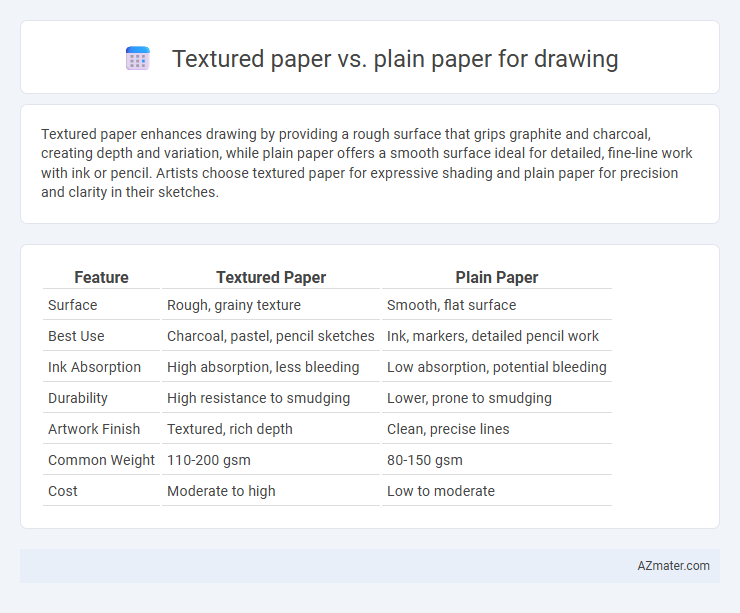Textured paper enhances drawing by providing a rough surface that grips graphite and charcoal, creating depth and variation, while plain paper offers a smooth surface ideal for detailed, fine-line work with ink or pencil. Artists choose textured paper for expressive shading and plain paper for precision and clarity in their sketches.
Table of Comparison
| Feature | Textured Paper | Plain Paper |
|---|---|---|
| Surface | Rough, grainy texture | Smooth, flat surface |
| Best Use | Charcoal, pastel, pencil sketches | Ink, markers, detailed pencil work |
| Ink Absorption | High absorption, less bleeding | Low absorption, potential bleeding |
| Durability | High resistance to smudging | Lower, prone to smudging |
| Artwork Finish | Textured, rich depth | Clean, precise lines |
| Common Weight | 110-200 gsm | 80-150 gsm |
| Cost | Moderate to high | Low to moderate |
Introduction to Drawing Paper Types
Textured paper, often known as cold-pressed or rough paper, offers a grainy surface that enhances pencil, charcoal, and pastel drawings by providing better grip and depth. Plain paper, typically smooth or hot-pressed, allows for precise, detailed work and is favored for ink, marker, and fine line drawings. Choosing between textured and plain paper depends on the desired effect, medium, and technique, making understanding these basic paper types essential for artists.
What is Textured Paper?
Textured paper, often known as cold press or rough paper, features a raised surface with visible grain that enhances the tactile experience and allows for greater pigment retention in drawing mediums like charcoal and pastel. Unlike plain paper, textured paper provides varied grip and friction, enabling artists to create richer, more dynamic shading and intricate detailing. This surface texture influences the paper's absorbency and interaction with materials, making it ideal for techniques requiring layering and blending.
What is Plain Paper?
Plain paper, characterized by its smooth surface, offers a consistent and even texture ideal for detailed drawings and precise line work. Unlike textured paper, which adds a tactile feel and grain that can influence shading and blending, plain paper allows for clean marks and fine detailing without interference from surface irregularities. Artists often prefer plain paper when accuracy and clarity in sketches or technical drawings are paramount.
Surface Texture: Key Differences
Textured paper features a rough or toothy surface that enhances pencil and charcoal grip, allowing for richer shading and greater depth in drawings. Plain paper offers a smooth, flat surface ideal for fine lines and detailed work but may limit the ability to create varied tonal effects. Artists select textured paper for expressive, dynamic renderings, while plain paper suits precision and clean, sharp details.
Impact on Pencil and Ink Techniques
Textured paper enhances pencil techniques by providing greater tooth, allowing for richer shading and better graphite adherence, ideal for detailed pencil sketches and layering. For ink work, textured surfaces can cause uneven ink flow and bleeding, challenging precision but adding character to expressive lines. Plain paper offers smoothness that benefits clean, sharp ink lines and controlled pencil marks, suitable for fine linework and technical drawings where detail clarity is crucial.
Color Application on Each Paper Type
Textured paper, with its rough surface, enhances color application by holding more pigment, creating rich, vibrant tones and allowing for layered techniques such as blending and shading. Plain paper's smooth surface offers precise lines and uniform color distribution but may hinder pigment adhesion, resulting in lighter, less saturated hues. Artists seeking intense color depth and dynamic texture prefer textured paper, while those requiring fine detail and even color often favor plain paper.
Suitability for Different Drawing Styles
Textured paper enhances graphite, charcoal, and pastel drawings by providing tooth that holds pigment effectively, making it ideal for expressive, detailed, and layered artwork. Plain paper offers a smooth surface that suits fine line work, ink drawings, and technical sketches requiring precision and clean edges. Artists often choose textured paper for rich shading and depth, while plain paper supports clarity and detail in minimalist or exacting styles.
Durability and Longevity Comparison
Textured paper offers enhanced durability due to its thicker fibers and embossed surface, which resist wear and tear better than smooth plain paper. Its rough texture helps to hold pigments firmly, preventing smudging and fading over time, thus increasing artwork longevity. In contrast, plain paper, while smoother and more suitable for fine detail, tends to degrade faster and shows wear more prominently under various environmental conditions.
Artist Preferences: Pros and Cons
Textured paper offers artists enhanced grip and depth, making it ideal for mediums like charcoal and pastel, while plain paper provides a smooth surface preferred for detailed ink and graphite work due to its precision. Many artists favor textured paper for its ability to add dimension and character to their strokes, though it may cause uneven wear on finer brushes and pens. Conversely, plain paper facilitates cleaner lines and easier erasing but can lack the vibrancy and tactile quality that textured paper naturally enhances.
Choosing the Right Paper for Your Artwork
Textured paper, such as cold-pressed or rough watercolor paper, offers better grip for charcoal, pastels, and graphite, enhancing depth and detail in drawings. Plain paper, often smooth and hot-pressed, allows for precise line work suitable for ink or detailed pencil sketches. Selecting the right surface depends on the medium and desired effect, with textured papers supporting rich shading and plain papers favoring clear, sharp lines.

Infographic: Textured paper vs Plain paper for Drawing
 azmater.com
azmater.com